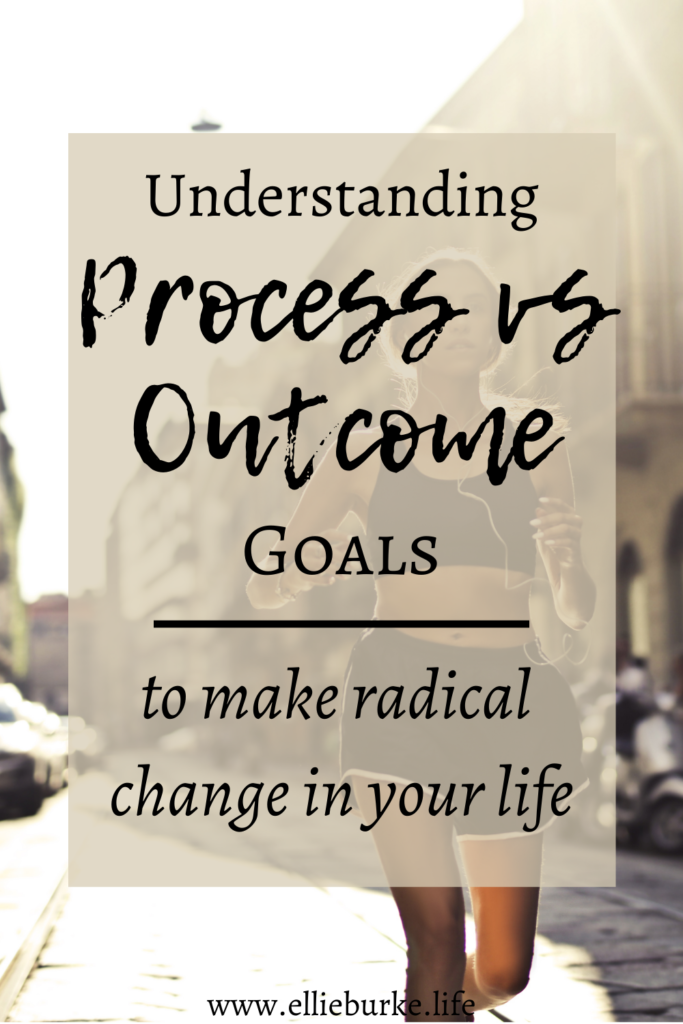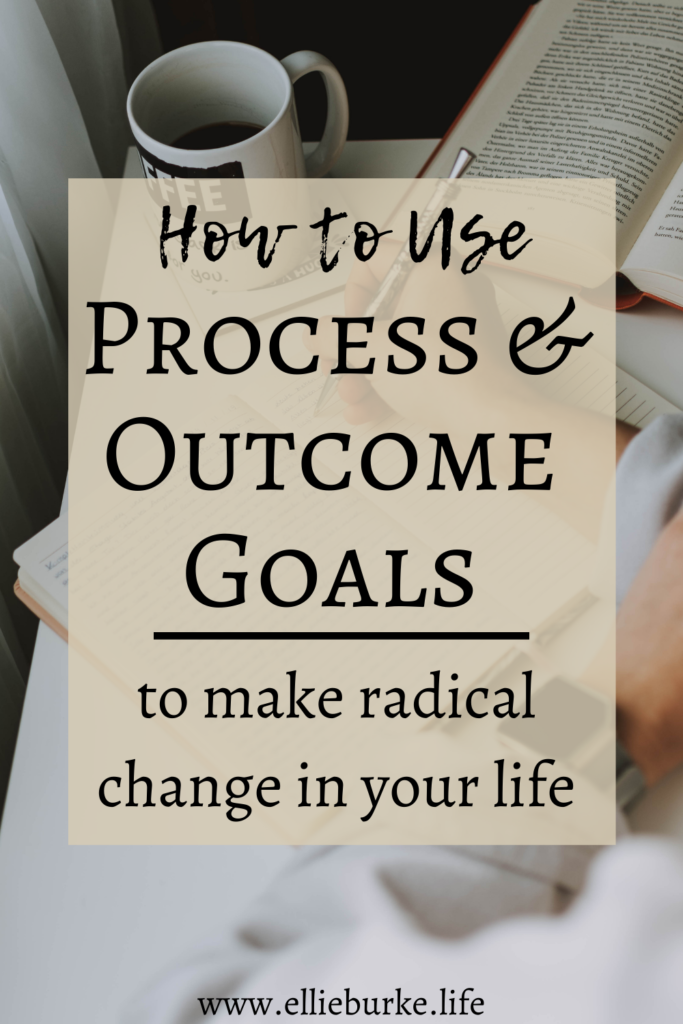Ellie Burke
Process Goals vs Outcome Goals- Little steps to big goals

In my last post, we talked about the importance of getting clear on your “why” and how that’s a super important step in supporting yourself to make meaningful change in your life. But now what?
My guess is you’ve gotten off-track or stuck in one of two places. One, you’ve lost momentum in the monotony of daily actions – the micro or “process”. Or, you’ve gotten overwhelmed by a far-off goal that seems too big/too far/too impossible – the macro or “outcome”.
In this post, we’re going to tie everything together. But first let’s discuss process goals vs outcome goals.
What are Process Goals?
Simply put, process goals are the specific actions or “processes” that a person accomplishes. These are small, daily tasks that can add up to a greater goal. For example, studying for an hour each day is a process goal.
These goals are completely controllable by each and every one of us. It is our choice to complete the task that day or not. Because they are so small, process goals are more tangible, actionable, and obtainable. The challenge with process goals on their own is that without a “greater purpose” and because of the way our brains are wired, we tend to default to old habits or whatever is easy or comfortable in the moment.
What are Outcome Goals?
Outcome goals are the big ones, the desired end result- the end goal if you will. Outcome goals are often things like running a marathon, passing your final exam, buying a house or decreasing stress. It’s the ultimate thing you want to achieve.
Focusing solely on an outcome goal can often feel too lofty, distant or unattainable because the goal, in and of itself, doesn’t directly outline the steps or actions needed in order to achieve it.
The Importance of Tying Process Goals to Outcome Goals
So let’s talk about the importance of tying your Process Goals to your Outcome Goals. We need to take little steps to big goals in order to achieve what’s most important to us. We need to be able to break down the macro into the tiniest of micro actions.
When we make a decision to create some kind of change in our lives, we tend to isolate these two things that really need to be brought together. We either only think of the long term vision or goal (outcome) or we only think of what we need to do today (process). When kept in isolation, we often have difficulty getting to the place we want to be.
Example
Think about a time when you’ve had to make a small decision on what to do. For instance, let’s say you are trying to train to run a 5k race in 6 weeks (outcome goal) through daily choices to walk/run for at least 20 minutes. Now you have had a busy and tiring day and are faced with a choice to squeeze in a 10 minute walk/run or kick back on the couch and chill for the rest of the evening.
When we isolate that decision (process goal) from our outcome goal, it can be easier to fall back on an old habit or an option that feels easier in the moment, aka chill on the couch. But when we factor in our outcome goal of building up to running a 5k, we feel more inclined to stick to the process goal of getting out for even a shorter than desired amount of time.
Without process goals (micro/daily actions), the end goal (outcome) can feel far-fetched and impossible to reach. This is why setting up daily and weekly goals that have been sized down to achievable tasks is so important. Without them, we will continue to pine for a future goal that feels unrealistic. Throw in some process goals and you can feel the steps getting you closer to your goal.
Think about the same scenario above but in reverse. You have decided you want to start exercising more but don’t tie an end goal to it. It proves to be very challenging to make new and/ or challenge your choices without the motivation of that end result. Without the goal of 5k in 6 weeks, or maybe relieving stress or having more energy, whatever the goal is for you – it is unlikely that we will choose to hit the pavement over and over again.
Without an end goal (outcome), our process goals (micro/daily actions) seem useless and unimportant. We need that outcome goal to motivate us to make the right decisions. This is where we also must tie in our why.
Tying in Your Why
So we have seen that in order to keep momentum and sustain small, process actions over time, we must have a clear outcome. But that outcome must be connected to a clear and emotional “why.”
Without the “why” we operate in a place very much unmoored and disconnected from something that feels meaningful, powerful, and hopeful. And the first bump we hit, the second roadblock, the third time we “fail” we will be sent into a frenzied, anxious, fearful place – a place that is not tethered to something more certain and more sure.
Knowing our why gets us to get up and do it again. To rest for a moment, to reorganize, to reassess and begin again. When you know your why, everything you do returns to it. Thus, the expression: _____ so that _____.
So let’s look at an example tying all three together- the “why”, outcome goal and process goals. Let’s say the outcome goal is to increase mobility and flexibility. This is important to you so that you can fend off injury and continue to participate in activities that keep you physically and mentally healthy (your why). In order to get there, you need small, actionable steps you can take on a daily/ weekly basis. So you set up goals to stretch after every workout for 5 minutes and attend at least 2 yoga classes a week (process goals).
Without the outcome goal and its deep tie to keeping you injury free and healthy, it will be harder to push yourself to those yoga classes. But with all three tied together in harmony, the end goal won’t feel so impossible and the process goals will have motivation behind them making them more achievable.
with love,
Ellie
Love this post? Pin it for later!
June 10, 2021


[…] having those goals in place doesn’t mean we’ll automatically achieve them! We have to create process goals or, what I like to call, “micro actions” that tie directly to our bigger, outcome goals. Those […]